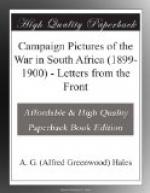In the meantime our whole transport came safely inside a little semi-circular valley, and arranged itself with almost ludicrous precision. The nigger drivers chaffed one another as the shells made melody above their heads, and made the air fairly dance with the picturesque terms of endearment they bestowed upon their mules, between the welts they bestowed with their long two-handed whips. When two of their leaders jibbed and refused to budge, they howled and called them Mr. Steyn and Ole Oom Paul; but when they got down solid to their work they laughed until even their back teeth were showing beyond the dusky horizon of their lips, and endowed them with the names of Cecil Rhodes and Mistah Chamberlain, which may or may not appear complimentary to the owners of those titles—anyway, the mules did not seem to be offended. One thing was made manifest to me then, and confirmed later on, viz., the nigger is a game fellow; give him a little excitement, and he is full of “devil”—it’s the doing of deeds in cold blood that finds him out. After seeing the way the transport was handled, I moved along to look at the ambulance arrangements, and found them practically perfect. The medical staff was cool and collected, the helpers were alert and attentive to business; the waggons, with their conspicuous red crosses, were all well and carefully placed—though in such a fight it was a sheer impossibility to dispose them so as to render them absolutely immune from danger, for shells have a knack of falling where least expected, and when they burst he is a wise man who falls flat on his face and leaves the rest to his Creator and the fortune of war. My next move was to secure a position on the top of a kopje, to try to gather some idea concerning the actual strength of the Boer position. It needed no soldier’s training to tell a man who knew the rugged Australian ranges thoroughly that the enemy had chosen his ground with consummate skill. To get at the Boers our men had either to go down the sides of the kopjes in full view of the clever enemy, or else make their way between narrow gullies, where shells would work havoc in their packed ranks. After they had reached the open, level ground, they had to cross open spaces of veldt commanded by the Boer guns and rifles, whilst the Boers themselves sat tight in a row of ranges that ran from east to west, mile after mile, in almost unbroken ruggedness. If we turned either flank, they could promptly fall back upon another line of kopjes as strong as those they held. Away behind their position the grim heights of Thaba Nchu rose towards the blue sky, solemn and stately. Far away to the eastward, a little south of east perhaps, I could see the hills that hid Wepener, distant about eighteen miles from the Boer centre. There we knew, and the enemy knew, that the Boers held a British force pinned in. They knew, and we knew, that Commandant Olivier, with eight or nine thousand men and a lot of guns, held the reins in his hands; and the men our force were engaging knew that unless they could keep us in check Olivier would soon be the hunted instead of the hunter.




